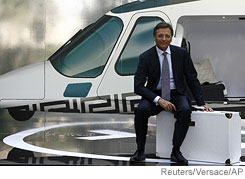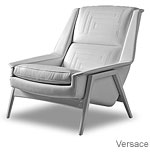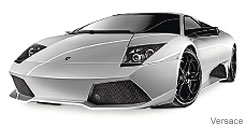At Versace, Fashion Is So Last Century
CEO Moves Past Clothes,
Emphasizes Lifestyle Goods;
Donatella Takes a Step Back
By STACY MEICHTRY
MILAN -- When Italian fashion house Gianni Versace SpA recently threw a cocktail party in the courtyard of its 16th-century palazzo to promote its latest creations, designer Donatella Versace ducked out of the soiree early, flanked by bodyguards.
Instead, Giancarlo Di Risio, Versace's bespectacled chief executive, presided over an evening that highlighted luxury goods: Parked at one end of the courtyard was a half-million-dollar Lamborghini Murciélago with a black-and-white leather interior by Versace. A huge poster showed an AgustaWestland helicopter with a Versace-designed cabin. Stacked nearby was luggage embossed with the brand's Greek motif, with pieces starting at about $4,000.
Mr. Di Risio is trying to shift Versace's attention away from clothes and to accessories, home interiors and other lifestyle products that will bring in new streams of revenue and offset fickle fashion cycles. "Fashion does not exist at Versace," he said, describing his strategy in an interview before the reception.
The new approach is bearing fruit. Versace swung back into the black last year, posting a $25.4 million profit after years of losses, and has shaken off millions in debt. Driving that turnaround were rising sales in the lucrative accessories Mr. Di Risio is pushing.
Yet the effects of the makeover have touched the core of the company's identity. Ms. Versace has begun taming the flamboyant clothing designs that once set her and the fashion house apart from the crowd. "I no longer recognize myself in that kind of woman," the 52-year-old Ms. Versace said in a telephone interview.
The culture shift at Versace highlights how an increasingly competitive fashion industry is forcing even the most freewheeling players to embrace a corporate culture. Many labels, including LVMH Moët Hennessy Louis Vuitton's smaller brands like Celine and Marc Jacobs, have also been toning down their looks to appeal to a wider swath of consumers. Designers who once called the shots are ceding authority to executives who run the numbers.
"In the beginning, it was a shock for me," Ms. Versace said. "When you tell a person who is used to being in power -- to saying yes or no on everything -- to take a step back, it's not easy. But it was necessary."
Tweaking a label's aesthetics carries risks. If pushed too far, transformations risk alienating loyal customers, says Robert Burke, head of New York-based luxury-goods consultancy Robert Burke Associates and the former fashion director at Bergdorf Goodman. "You will always want to see a fashion edge to Versace," he says.
Yet for family-owned fashion labels like Versace, pressure to make more money is high. They compete with publicly traded conglomerates such as LVMH and PPR SA's Gucci Group, which have the financial heft to expand with stores in the emerging markets of China, India and Russia -- seen as fueling the industry's growth.
A number of Italy's top family-owned fashion houses, including Versace, Prada SpA and Salvatore Ferragamo SpA, are considering stock-market listings in the next couple of years. "An IPO would be the best way to raise money and implant in these countries," says Peter Farren, a luxury-goods analyst at the French investment firm Bryan Garnier.
At Versace, a sobering realization is spurring Mr. Di Risio's moves: The clothes that once made the brand are now struggling to make money.
In its heyday in the early 1990s, Versace stayed ahead of the fashion mainstream with lavish catwalk shows that celebrated the racy designs of founder Gianni Versace. The label amassed collections of real estate and artwork that enhanced the family's jet-setter status.
The company found it increasingly tough to squeeze profits out of highly perishable fashions as production costs rose in Italy. In 1997, Mr. Versace was murdered outside his Miami villa. The firm's finances went into a tailspin, and it was forced to shelve plans to go public. Mr. Versace's 50% stake in the label went to his niece, Ms. Versace's then-preteen daughter Allegra Versace Beck, shifting the balance of power. Though Ms. Versace owns only 20% of the company, she was seen to exert huge influence because of her daughter's stake. A third sibling, Santo Versace, owns the remaining 30% of the company. Ms. Versace Beck, now 20 years old, manages her stake with the help of advisers.
The Versace stakeholders decided the company needed a CEO who could turn the company around. Fabio Cacciatori, at one time an outside financial consultant for the company, became CEO in September 2003 but resigned in December. The company named Versace's then-Chief Financial Officer Daniele Ballestrazzi interim CEO as it searched for new leadership.
When Versace recruited Mr. Di Risio from LVMH's Fendi label in the summer of 2004, the house was saddled with more than $146 million in debt and heading to a net loss of $124 million for the year, on revenue of $416 million. High-end retailers like Bergdorf Goodman had stopped carrying the brand.
Bergdorf Chief Executive Jim Gold recalls that Versace was distributing too widely, diluting its exclusivity, and was overly consumed with making a splash on the runway. While many labels had started delivering retailers fresh designs more frequently, ahead of the runway collections, Versace resisted.
Mr. Di Risio arrived with a new mantra. Clothing that is too fashionable, he told his lieutenants, is bad for business because it eats up capital and goes out of style quickly. Accessories and other leather goods are a better bet because they have a longer shelf life and fatter profit margins.
To reduce Versace's dependence on fashion, Mr. Di Risio shut down lines such as Versace Intimates lingerie and Versace Young, a children's line. The company sold its unprofitable perfume, jewelry and watchmaking divisions, replacing them with lucrative licensing agreements with U.S. watch group Timex Corp. and Italian perfume and cosmetics maker EuroItalia Srl.
Mr. Di Risio homed in on the company's shoes and handbags, which have higher profit margins because they cost less to produce than clothes but are easier to sell to a wide array of customers. Last year, more than 30% of Versace's $383 million in revenue came from accessories, compared with 4% when Mr. Di Risio arrived.
He also expanded the label's push into home furnishings -- a business that generated sales of $82.5 million in 2006, up 55% from the year before. Versace recently unveiled its "Jet Seat," an aerodynamically-styled leather chair in a high-tech ceramic frame that is sold in Europe for €38,000 (about $50,000).
"It was like taking a blank page and rewriting everything," Mr. Di Risio says.
To succeed, however, he had to get Ms. Versace on board. She had hoped to resurrect the costly haute-couture fashion shows the label had discontinued before Mr. Di Risio's arrival. But he argued she could more effectively enhance the line's exclusivity by holding showings for individual clients.
"I said to Di Risio, 'This is not going to work. This is going to die,'" recalled Ms. Versace. But, she said, "I was wrong, and he was right. We sell more now."
Ms. Versace had to become more conscious of how much time and money the label invests in promoting designs at events like the Oscars. Last year, the designer dressed actresses Hilary Swank, Uma Thurman and Salma Hayek and director Robert Altman's wife, Kathryn Reed Altman, who donned a navy-blue sequin gown.
This year, however, Ms. Versace limited herself to one gown, designing a rose-colored dress with a sweeping train for best-actress nominee Penelope Cruz.
For Versace's ready-to-wear line, Ms. Versace is going for looks she calls "a little more understated." Bergdorf Goodman will carry her designs in the fall for the first time in years.
Ms. Versace is also working more closely with retailers, adding four more collections beyond the traditional spring and fall runway collections. These are shown to retailers in private visits, giving them a preview of what to expect.
On the financial side, Mr. Di Risio has untangled the company's assets from those of the family, selling property he deemed "nonstrategic" to pay the company's debts. The family's Manhattan townhouse was sold for about $35 million, and its contents went up for auction in 2005. The paintings alone -- including works by artists Andy Warhol, Jean-Michel Basquiat, Roy Lichtenstein and Julian Schnabel -- fetched more than $11 million dollars.
Flagship stores in New York, London and Milan that Mr. Di Risio described as "decadent and sad," were redone with sleek, minimalist designs.The label, which operates 82 stores and has 35 franchise operations, plans to open more than 10 boutiques by the end of the year, including seven stores in China alone. When Versace opened the doors of its updated Moscow boutique in April, an array of leather bags, belts and shoes greeted customers at the store's lacquered ground-floor entrance. The label's ready-to-wear collection was relegated to the upper floor
story and images from wsj.com
</H1>
























